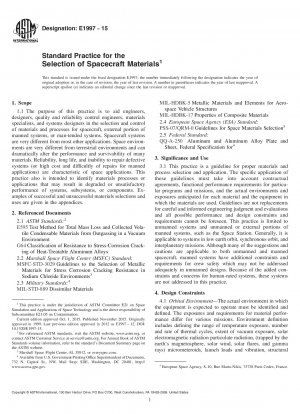ASTM E1997-15
Standard Practice for the Selection of Spacecraft Materials
- Standard No.
- ASTM E1997-15
- Release Date
- 2015
- Published By
- American Society for Testing and Materials (ASTM)
- Status
- Replace By
- ASTM E1997-15(2021)
- Latest
- ASTM E1997-15(2021)
- Scope
3.1 This practice is a guideline for proper materials and process selection and application. The specific application of these guidelines must take into account contractual agreements, functional performance requirements for particular programs and missions, and the actual environments and exposures anticipated for each material and the equipment in which the materials are used. Guidelines are not replacements for careful and informed engineering judgment and evaluations and all possible performance and design constraints and requirements cannot be foreseen. This practice is limited to unmanned systems and unmanned or external portions of manned systems, such as the Space Station. Generally, it is applicable to systems in low earth orbit, synchronous orbit, and interplanetary missions. Although many of the suggestions and cautions are applicable to both unmanned and manned spacecraft, manned systems have additional constraints and requirements for crew safety which may not be addressed adequately in unmanned designs. Because of the added constraints and concerns for human-rated systems, these systems are not addressed in this practice.
1.1 The purpose of this practice is to aid engineers, designers, quality and reliability control engineers, materials specialists, and systems designers in the selection and control of materials and processes for spacecraft, external portion of manned systems, or man-tended systems. Spacecraft systems are very different from most other applications. Space environments are very different from terrestrial environments and can dramatically alter the performance and survivability of many materials. Reliability, long life, and inability to repair defective systems (or high cost and difficultly of repairs for manned applications) are characteristic of space applications. This practice also is intended to identify materials processes or applications that may result in degraded or unsatisfactory performance of systems, subsystems, or components. Examples of successful and unsuccessful materials selections and uses are given in the appendices.
ASTM E1997-15 Referenced Document
- ASTM E595 Standard Test Method for Total Mass Loss and Collected Volatile Condensable Materials from Outgassing in a Vacuum Environment
- ASTM G64 Standard Classification of Resistance to Stress-Corrosion Cracking of Heat-Treatable Aluminum Alloys
ASTM E1997-15 history
- 2021 ASTM E1997-15(2021) Standard Practice for the Selection of Spacecraft Materials
- 2015 ASTM E1997-15 Standard Practice for the Selection of Spacecraft Materials
- 2012 ASTM E1997-12 Standard Practice for the Selection of Spacecraft Materials
- 2007 ASTM E1997-07 Standard Practice for the Selection of Spacecraft Materials
- 1999 ASTM E1997-99(2003)e1 Standard Practice for the Selection of Spacecraft Materials
- 1999 ASTM E1997-99 Standard Practice for the Selection of Spacecraft Materials
